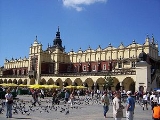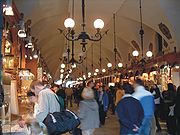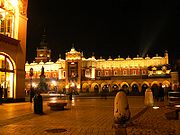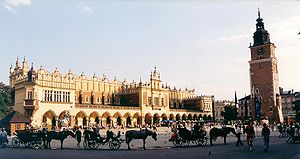
Sukiennice
Encyclopedia
.jpg)



Renaissance in Poland
The Renaissance in Poland lasted from the late 15th to the late 16th century and is widely considered to have been the Golden Age of Polish culture. Ruled by the Jagiellon dynasty, the Kingdom of Poland actively participated in the broad European Renaissance...
Sukiennice (Cloth Hall, Draper
Draper
Draper is the now largely obsolete term for a wholesaler, or especially retailer, of cloth, mainly for clothing, or one who works in a draper's shop. A draper may additionally operate as a cloth merchant or a haberdasher. The drapers were an important trade guild...
s' Hall) in Kraków
Kraków
Kraków also Krakow, or Cracow , is the second largest and one of the oldest cities in Poland. Situated on the Vistula River in the Lesser Poland region, the city dates back to the 7th century. Kraków has traditionally been one of the leading centres of Polish academic, cultural, and artistic life...
, Poland
Poland
Poland , officially the Republic of Poland , is a country in Central Europe bordered by Germany to the west; the Czech Republic and Slovakia to the south; Ukraine, Belarus and Lithuania to the east; and the Baltic Sea and Kaliningrad Oblast, a Russian exclave, to the north...
, is one of the city's most recognizable icons. It is the central feature of the Main Market Square
Main Market Square, Kraków
The Main Market Square in Kraków is the most important market square of the Old Town in Kraków, Poland and a principal urban space located at the center of the city...
in the Kraków Old Town (listed as the UNESCO
UNESCO
The United Nations Educational, Scientific and Cultural Organization is a specialized agency of the United Nations...
World Heritage Site
World Heritage Site
A UNESCO World Heritage Site is a place that is listed by the UNESCO as of special cultural or physical significance...
since 1978). It was once a major centre of international trade. Traveling merchants met there to discuss business and to barter. During its golden age in the 15th century, Sukiennice was the source of a variety of exotic imports from the East – spices, silk, leather and wax – while Kraków itself exported textile
Textile
A textile or cloth is a flexible woven material consisting of a network of natural or artificial fibres often referred to as thread or yarn. Yarn is produced by spinning raw fibres of wool, flax, cotton, or other material to produce long strands...
s, lead
Lead
Lead is a main-group element in the carbon group with the symbol Pb and atomic number 82. Lead is a soft, malleable poor metal. It is also counted as one of the heavy metals. Metallic lead has a bluish-white color after being freshly cut, but it soon tarnishes to a dull grayish color when exposed...
, and salt
Salt
In chemistry, salts are ionic compounds that result from the neutralization reaction of an acid and a base. They are composed of cations and anions so that the product is electrically neutral...
from the Wieliczka Salt Mine.
Kraków – Poland's royal capital – was among the most magnificent cities in Europe
Europe
Europe is, by convention, one of the world's seven continents. Comprising the westernmost peninsula of Eurasia, Europe is generally 'divided' from Asia to its east by the watershed divides of the Ural and Caucasus Mountains, the Ural River, the Caspian and Black Seas, and the waterways connecting...
already from before the time of the Renaissance
Renaissance
The Renaissance was a cultural movement that spanned roughly the 14th to the 17th century, beginning in Italy in the Late Middle Ages and later spreading to the rest of Europe. The term is also used more loosely to refer to the historical era, but since the changes of the Renaissance were not...
. However, its prosperity would not last indefinitely. The city's decline was hastened by wars and politics leading to the Partitions of Poland
Partitions of Poland
The Partitions of Poland or Partitions of the Polish–Lithuanian Commonwealth took place in the second half of the 18th century and ended the existence of the Polish–Lithuanian Commonwealth, resulting in the elimination of sovereign Poland for 123 years...
at the end of the 18th century. By the time of the architectural restoration proposed for Sukiennice in 1870 under Austro-Hungarian rule, much of the historic city center was decrepit. Nevertheless, a change in political fortunes for the Kingdom of Galicia and Lodomeria
Kingdom of Galicia and Lodomeria
The Kingdom of Galicia and Lodomeria was a crownland of the Habsburg Monarchy, the Austrian Empire, and Austria–Hungary from 1772 to 1918 .This historical region in eastern Central Europe is currently divided between Poland and Ukraine...
ushered in a local revival of sorts due to newly established Legislative Assembly or Sejm
Sejm
The Sejm is the lower house of the Polish parliament. The Sejm is made up of 460 deputies, or Poseł in Polish . It is elected by universal ballot and is presided over by a speaker called the Marshal of the Sejm ....
, and the successful renovation of the Cloth Hall was one of the proudest achievements of this period.
The Hall has hosted countless distinguished guests over the centuries and is still used to entertain monarchs and dignitaries. Britain's Prince Charles and Emperor Akihito
Akihito
is the current , the 125th emperor of his line according to Japan's traditional order of succession. He acceded to the throne in 1989.-Name:In Japan, the emperor is never referred to by his given name, but rather is referred to as "His Imperial Majesty the Emperor" which may be shortened to . In...
of Japan
Japan
Japan is an island nation in East Asia. Located in the Pacific Ocean, it lies to the east of the Sea of Japan, China, North Korea, South Korea and Russia, stretching from the Sea of Okhotsk in the north to the East China Sea and Taiwan in the south...
were welcomed here in 2002. In times gone by, balls were held here, most notably after Prince Józef Poniatowski had liberated the city from the Austrian Empire
Austrian Empire
The Austrian Empire was a modern era successor empire, which was centered on what is today's Austria and which officially lasted from 1804 to 1867. It was followed by the Empire of Austria-Hungary, whose proclamation was a diplomatic move that elevated Hungary's status within the Austrian Empire...
in 1809. Aside from its grand history and great cultural value, the hall still flourishes as a bustling center of commerce, albeit offering items for sale that are radically different from those of previous centuries — mainly souvenirs for tourists.
Other, similar cloth halls have existed in other Polish as well as other European cities such as in Ypres, Belgium
Cloth Hall, Ypres
The Cloth Hall , of Ypres, Belgium, was one of the largest commercial buildings of the Middle Ages, when it served as the main market and warehouse for the Flemish city's prosperous cloth industry. The original structure, erected mainly in the 13th century and completed 1304, lay in ruins after...
; Braunschweig, and in Leeds, England
1st White Cloth Hall
The 1st White Cloth Hall is a Grade II* listed building in the city centre of Leeds in West Yorkshire, England.-History:Originally named The White Cloth Hall, it was opened in 1711 as a response to the building of a covered cloth hall by the merchants of Wakefield in 1710, in order to entice...
; but the one in Kraków
Kraków
Kraków also Krakow, or Cracow , is the second largest and one of the oldest cities in Poland. Situated on the Vistula River in the Lesser Poland region, the city dates back to the 7th century. Kraków has traditionally been one of the leading centres of Polish academic, cultural, and artistic life...
is the best-known and best-preserved.
See also
- Sukiennice MuseumSukiennice MuseumSukiennice Museum, a.k.a. Gallery of 19th-Century Polish Art at Sukiennice, is a division of the National Museum, Kraków, Poland. The Gallery is housed on the upper floor of the Sukiennice in the center of the Main Market Square in Old Town Kraków.-History of the collection:The Gallery holds the...
, division of the National Museum - National Museum, KrakówNational Museum, KrakówThe National Museum in Kraków , established in 1879, is the main branch of Poland's National Museum, which has many permanent collections around the country.-History:...
- Kraków Main Market SquareMain Market Square, KrakówThe Main Market Square in Kraków is the most important market square of the Old Town in Kraków, Poland and a principal urban space located at the center of the city...
(Rynek Główny) - Kraków Old Town (Stare Miasto)
- Culture of KrakówCulture of KrakówKraków is considered by many to be the cultural capital of Poland. It was named the European Capital of Culture by European Union for the year 2000. The city has some of the best museums in the country and several famous theaters...
- Events in KrakówEvents in KrakowThe historic city of Kraków, Poland, especially the Old Town, is the hub of many outdoor and indoor festivals, cultural events and street parades. Many of them are seasonal and take place only one time, while others are organised annually for many years by various festival societies...

